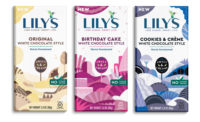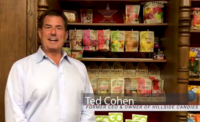Sugar-free sales are a huge slice of the confectionery market, and candy makers are happy to meet the demand.
In fact, in the United States the category has increased to nearly $693.3 million in sales in 2012, up from about 635.1 million in 2008, according to data from Euromonitor International.
Some of the categories that saw a notable increase over the last few years include:
- Sugar-free lollipops, which increased to $38 million in 2012, up from $30.5 million in 2008
- Sugar-free mints, which increased to $354.6 million in 2012, up from $327.5 million in 2008
- Sugar-free pastilles, gums, jellies and chews, which increased to $117.8 million, up from $86.7 million in 2008.
And, while sugar-free chocolate sales are down 4.49 percent from last year, there were still $131.7 million in sales in the category in the last 12 months, according to data from IRI ending Nov. 3, 2013, the latest data available.
The top player in the sugar-free chocolate category is Russell Stover’s, whose first sugar-free candy hit the market 25 years ago.
The company has 70.6 percent of the sugar-free chocolate category, and in the last year, Russell Stover’s sold $93 million in sugar-free sales, according to data from IRI.
The candy company offers hundreds of sugar-free candies, and continues to innovate within the sector.
Mark Sesler, senior v.p. and chief marketing officer at Russell Stover, says that aside from the large share of the U.S. market, they do very well in Canada, Mexico, and Australia as well.
The company also sells seven of the top 10 sugar-free candies in the peg bag segment — the most popular package for sugar-free candy. And they sell the three top spots: pecan delight, mint patty and coconut.
“The ‘secret’ to our success is taste; we are acknowledged as having the best tasting sugar-free [candy] available in the marketplace,” Sesler explains.
Sugar-free gum and mint sales declining:
Although most of the sugar-free sectors are gradually increasing, one category is actually decreasing slightly.
Sugar-free gum sales decreased 6.17 percent in the last 12 months, according to IRI data.
But even though the sales of sugar-free gum are down, the category is still the largest sugar-free market by far.
With $2.7 billion in sales, it’s not only bigger than the sugar-free chocolate market ($131.7 million) and the sugar-free diet candy sector ($106.9 million), it’s also about quadruple the size of the sugar gum market ($518.2 million), according to IRI data.
Some of the top sugar-free gums include: Orbit, Trident, Wrigley’s Extra, Wrigley’s Eclipse, Wrigley’s 5, and Dentyne Ice, Stride, andIce Breakers.
Hershey’s says it plans to introduce Ice Breakers Duo Watermelon soon.
“[It’s] a new flavor of Ice Breakers Duo Mints that gives consumers both a sweet and refreshing taste,” says Laura Renaud, associate manager of corporate communications for The Hershey Co.
In fact, it usually is easier to create the crisp and refreshing flavor that most gums and mints call for with a sugar substitute.
For example, Thomas E. Parady, Roquette’s associate program coordinator for food and industrial applications, says xylitol helps them achieve a cooling factor in products.
Creating sugar-free candies that also taste good continues to be on ongoing struggle though, and the search for the elusive sugar substitute that tastes just like sugar never seems to end.
Hershey’s sugar-free products are sweetened with sugar alcohols (or polyols), such as xylitol, mannitol, sorbitol, erythritol, and lactitol, which contain some calories and increase blood sugar levels to varying degrees.
And, Russell Stover uses a proprietary blend of maltitol and Splenda.
“Over the years, we have used isomalt, inulin and erythritol in various combinations, but have found we have a more consistent delivery of good taste with our current blend,” Sesler says.
Meanwhile, Melanie Goulson, Truvia stevia leaf extract application manager at Cargill, says the plant is ideal for supplementing the lower sweetness of polyols in sugar-free confectionery formulations.
For example, she points to recent launches in Europe that have used Cargill’s Truvia stevia leaf extract, including: Torras’ line of sugar-free chocolate products; Stevi-Lakritz licorice by confectionery giant Haribo; and aspartame-free gum by Denmark’s Gumlink.
Indeed, as the category continues to grow, manufactures are offering more variety for consumers.
Russell Stover, for example, now offers more than 25 sugar-free flavors, in packages ranging from single-serve bars to instant consumables, to gift boxes, gusset bags, lay down bags, peg bags and even breakfast bars.
“We’ve introduced no less than five new items every year for the past 3 years,” Sesler says.
Among those launches were two new peg bag flavors, including solid dark chocolate, and coconut and almond. The confectioner also has introduced new packaging types for existing flavors. And, plans to introduce eight more items in the first quarter of this year.
Another new sugar-free treat to enter the market in the last year is the Sinfully Delicious Squeeze Candy from Innovative Candy Concepts.
The creamy chocolate is completely sugar-free, fat-free and less than 75 calories and comes in three flavors: Creamy Chocolate, Chocolate Caramel Swirl, and Chocolate Cheesecake. In addition, a Dark Chocolate flavor also is in the works. The suggested retail price for the 1-oz. packs is $0.89-$1.29
Armand Hammer, the president and ceo of Innovative Candy Concepts makes all of his candy sugar-free and has since 2004. He says he made the decision to eliminate sugar from his confections after seeing a child at a family gathering eating his treats when they still had sugar in them and realizing the impact he could have by making the switch.
Over the years, he’s worked hard to create sugar-free formulas delicious enough to tempt kids.
“Let’s face it, kids are going to eat candy. We want to provide them with a better alternative,” Hammer explains.
He goes on to say that the industry tends to ignore children’s confections when they create sugar-free treats.
“We hope other companies will soon follow, because the demand is already there,” Hammer says. “The kid’s candy market has been ignored. That is changing and we’re a big part of the change.”
The company’s strategy seems to be working. Too Tarts Smart Choices was the number five selling sugar-free diet candy in the last 12 months, according to data from IRI.
If that’s any indication of the future, it could mean that sugar-free kid’s candy is the next big category. And as the sweeteners evolve, and the manufacturers continue to hone their recipes, it’s not hard to fathom that the children they’re marketing the new sugar-free treats to might even like them.













